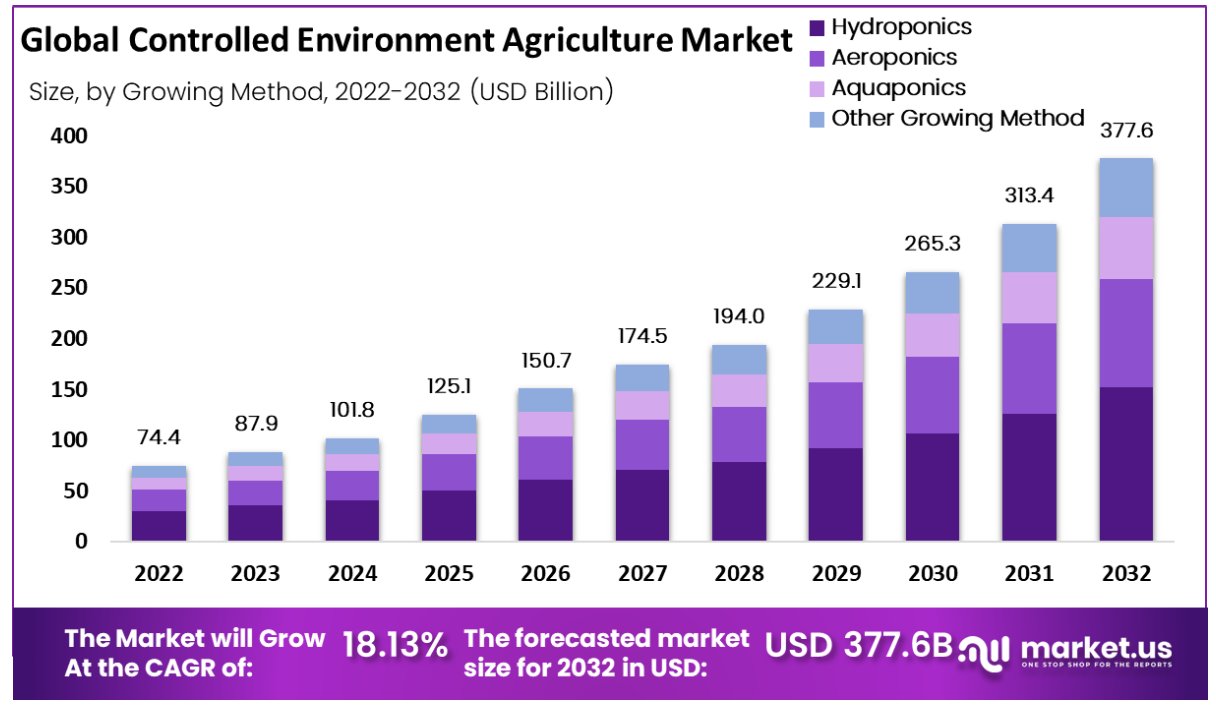Controlled Environment Agriculture Market Revenues Projected To Reach USD 377.6 Bn By 2032 With A 18.13% CAGR

Page Contents
Market Overview
Published Via 11Press : Controlled Environment Agriculture Market refers to cultivating plants in an enclosed environment in which various parameters, including temperature, humidity, light intensity, and nutrient levels can be precisely managed. CEA utilizes technologies like greenhouse systems, vertical farming, and hydroponics in order to provide plants with ideal growing environments.
The Controlled Environment Agriculture Market Size Was To Reach USD 74.4 Billion In 2022 And is Projected To Reach a Revised Size Of USD 377.6 Billion By 2032, Growing At A CAGR of 18.13 %
CEA market growth has experienced rapid expansion over recent years due to multiple factors. CEA allows year-round cultivation regardless of external weather conditions, creating an abundant and continuous source of fresh produce in regions with extreme climates or limited arable land. This feature makes CEA particularly advantageous.
To Get Additional Highlights On Major Revenue-Generating Segments, Request the Controlled Environment Agriculture Market Sample Report At – https://market.us/report/controlled-environment-agriculture-market/request-sample/

Additionally, CEA brings several other advantages. It facilitates efficient resource utilization by decreasing water consumption and herbicide needs while mitigating soil erosion risk by abandoning traditional soil-based agriculture techniques. Furthermore, its controlled environment reduces diseases and pest infestation, leading to greater crop yields with enhanced quality results.
Key Takeaways
- Growing Demand: The controlled environment agriculture (CEA) market is experiencing notable expansion as consumers become more interested in safe food solutions like CEA technologies that produce no pesticide residue or residual chemicals in them. Consumers increasingly care about food quality and sustainability issues which drives this technology forward.
- Efficient Resource Utilization: CEA techniques such as hydroponics, aeroponics, and aquaponics facilitate efficient resource usage. By requiring less water, land, and fertilizers than traditional farming practices do CEA is often an attractive solution in regions with limited resources for agricultural production.
- Year-Round Production: CEA offers year-round cultivation without seasonal limitations, guaranteeing farmers consistent supplies of crops throughout the year. By creating optimal growing conditions — temperature, humidity, and lighting among them — CEA allows farmers to extend growing seasons even in harsh climates by creating optimal growing conditions that enable year-round crop production.
- Improved Crop Quality and Yield: CEA facilities enable farmers to exert precise control over various growth factors for enhanced crop quality and higher yields. By optimizing lighting, nutrient delivery, environmental conditions, and pest management procedures CEA farmers can achieve faster growth rates and superior control against pests and diseases.
| Country | 2022 – Revenue Share (%) |
| The United States | 35.2 |
| Germany | 12.8 |
| Australia | 7.0 |
| Japan | 6.4 |
| North America | 49.4 |
| Europe | 26.2 |
| United Kingdom | 2.4 |
Country Wise Growth Rate (%)
| Country | Growth Rate CAGR (%) |
| India | 27.3 |
| China | 26.2 |
| South Korea | 25.1 |
| Canada | 24.0 |
| Mexico | 22.9 |
| France | 21.8 |
| Singapore | 20.7 |
Drivers
- Consumer Demand for Local Produce: With increasing consumer interest in produce grown close to consumers and with minimal carbon emissions, local production of fruits, vegetables, and herbs are in greater demand than ever before. CEA allows year-round production closer to urban centers so as to satisfy this consumer need for locally sourced food products.
- Need for Sustainable Agricultural Practices: Traditional agriculture techniques often entail excessive water usage, chemical inputs, and land degradation. CEA offers an eco-friendly solution by minimizing water consumption, decreasing pesticide reliance, and using vertical farming techniques for maximum land efficiency – driving CEA adoption forward. The need for eco-friendly agricultural practices drives its adoption.
- Climate Change and Unpredictable Weather Patterns: Climate change and extreme weather events like droughts, floods, and heatwaves present traditional agriculture with numerous difficulties that impact its production of crops and food products. CEA provides a controlled environment that is immune from external conditions; as a result, it ensures consistent crop production regardless of climate fluctuations.
Market Segments
Based on Growing Method
- Hydroponics
- Aeroponics
- Aquaponics
- Other Growing Method
Based on Components
- Lighting
- Climate Control
- Nutrients
- Other Components
Based on Crop Types
- Tomato
- Leafy Greens
- Strawberries
- Cucumber
- Pepper
- Cannabis
- Other Crop Types
Market Key Players
- Aero Farms
- Gotham Greens
- Plenty
- Lufa Farms
- IDEA Protected Horticulture
- Green Sense Farms
- Metro Farms
- Mirai
- Sky Greens
- Greenland
- Scafil
- Jingpeng
- Metropolis Farms
- Garden Fresh Farms
- Infinite Harvest
- Other Key Players
To Understand How Our Report Can Bring a Difference To Your Business Strategy, Inquire About A Brochure at https://market.us/report/controlled-environment-agriculture-market/#inquiry
Opportunities
- Rising Urbanization: CEA can take advantage of rapid urban population growth to produce fresh produce suitable for consumption in an expanding city environment. Vertical farming and rooftop gardens allow CEA techniques such as food production to produce food efficiently within urban settings to satisfy consumer demands.
- Growing Organic and Specialty Crop Market: Consumer awareness of health and environmental concerns has resulted in an expanding organic and specialty crop market. CEA provides an ideal environment for organic farming by eliminating synthetic pesticides while permitting precise control over inputs; in addition, CEA facilitates the cultivation of specialty crops with specific growth requirements to meet niche market demands.
- Technological Advancement and Innovation in CEA: CEA continues to make great advances technologically, offering ample opportunity for further advancement and advancement of products such as automation robots artificial intelligence data analytics that enhance production processes optimize resource use efficiency reduce labor requirements further research is ongoing to further advance CEA systems and create groundbreaking new solutions
- Growth Opportunities in Emerging Markets: CEA has seen substantial opportunities to grow its operations in emerging economies across Asia, Latin America, and Africa, which present CEA with incredible expansion potential. While emerging economies in these regions often face issues related to food security issues such as limited arable land or climate variability.
Challenges
- Initial Investment Costs Are Considered Significant: CEA systems involve considerable setup costs that include infrastructure development, technology implementation, and equipment acquisition – creating barriers to small farmers or newcomers taking up CEA technologies widely. This initial investment may act as an impediment.
- Operational Costs: Running a CEA facility involves ongoing expenses that include energy costs, maintenance, labor expenses, and inputs such as seeds and nutrients – these operational expenses may exceed traditional farming methods so careful financial planning and efficient management must take place to ensure the profitability of this investment.
- Complexity and Technical Expertise: CEA systems can be complex systems requiring extensive specialized knowledge and technical skills for proper operation and maintenance. Achieving optimal environmental conditions, managing complex automation systems, and troubleshooting technical issues may prove challenging, necessitating skilled labor and ongoing training for maximum effectiveness.
- Energy Consumption: CEA facilities rely heavily on artificial lighting, heating, and ventilation systems as energy-intensive systems to achieve ideal growing environments for their crops. Excessive energy use not only increases operational costs but raises concerns over environmental impacts associated with CEA practices as well as concerns for sustainability; creating energy-saving solutions is therefore vital to long-term viability for CEA farms.
Recent Development
- Technological Advancements: CEA technologies have seen remarkable advances, due to the combination of automation, artificial intelligence (AI), and the Internet of Things (IoT). These advancements allow real-time monitoring, precise control over environmental parameters, and data-driven decision-making processes that improve efficiency, productivity, and resource management resulting in enhanced systems efficiency and resource utilization.
- Vertical Farming Expansion: Vertical farming facilities have seen remarkable expansion, creating efficient land utilization while serving consumers nearby. This trend can be linked to both increasing consumer demands for locally produced products as well as underutilized urban spaces becoming available for development.
- Indoor Farming Innovations: Indoor farming innovations range from warehouse-based systems and container farms, through modular and scalable indoor farming systems for flexible production capacities to robotics/AI integration for automated planting/harvesting/monitoring processes that have gained ground.
Report Scope
| Report Attribute | Details |
| The market size value in 2023 | USD 74.4 Bn |
| Revenue Forecast by 2032 | USD 377.6 Bn |
| Global Market Growth Rate (2023 to 2032) | CAGR Of 18.13 % |
| Regions Covered | North America, Europe, Asia Pacific, Latin America, and Middle East & Africa, and Rest of the World |
| Historical Years | 2017-2022 |
| Base Year | 2022 |
| Estimated Year | 2023 |
| Short-Term Projection Year | 2028 |
| Long-Term Projected Year | 2032 |
FAQs
Q1: What is Controlled Environment Agriculture (CEA)?
A1: Controlled Environment Agriculture (CEA) refers to the practice of growing crops in a controlled environment, such as greenhouses or indoor facilities, where various environmental factors like temperature, humidity, lighting, and CO2 levels can be precisely controlled.
Q2: How big is the Controlled Environment Agriculture Market?
A2: The global Controlled Environment Agriculture Market size was estimated at USD 74.4 billion in 2022 and is expected to reach USD 377.6 billion in 2032.
Q3: What is the Controlled Environment Agriculture Market growth?
A3: The global Controlled Environment Agriculture Market is expected to grow at a compound annual growth rate of 18.13%.
Q4:Who are the key companies/players in the Controlled Environment Agriculture Market?
A4:Some of the key players in the Controlled Environment Agriculture Markets are Aero Farms, Gotham Greens, Plenty, Lufa Farms, IDEA Protected Horticulture, Green Sense Farms, Metro Farms, Mirai, Sky Greens, Greenland, Scafil, Jingpeng, Metropolis Farms, Garden Fresh Farms, Infinite Harvest, Other Key Players
Q5: What are the benefits of CEA?
A5: CEA offers several benefits, including year-round production, optimized resource utilization, improved crop quality and yield, reduced environmental impact, and the ability to grow crops in regions with limited arable land or unfavorable climates.
Contact
Global Business Development Team – Market.us
Market.us (Powered by Prudour Pvt. Ltd.)
Send Email: [email protected]
Address: 420 Lexington Avenue, Suite 300 New York City, NY 10170, United States
Tel: +1 718 618 4351
Website: https://market.us/
Content has been published via 11press. for more details please contact at [email protected]
The team behind market.us, marketresearch.biz, market.biz and more. Our purpose is to keep our customers ahead of the game with regard to the markets. They may fluctuate up or down, but we will help you to stay ahead of the curve in these market fluctuations. Our consistent growth and ability to deliver in-depth analyses and market insight has engaged genuine market players. They have faith in us to offer the data and information they require to make balanced and decisive marketing decisions.



